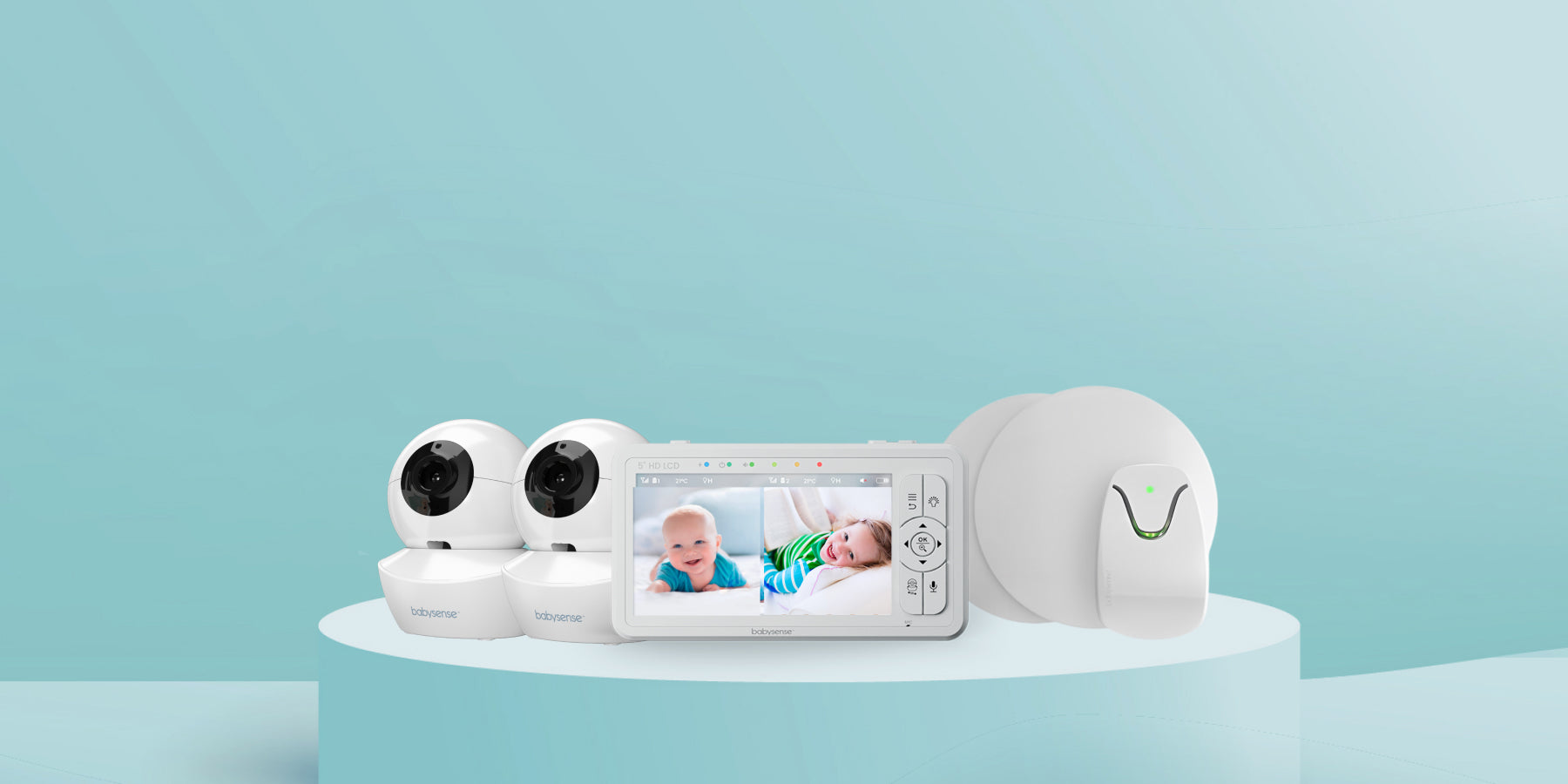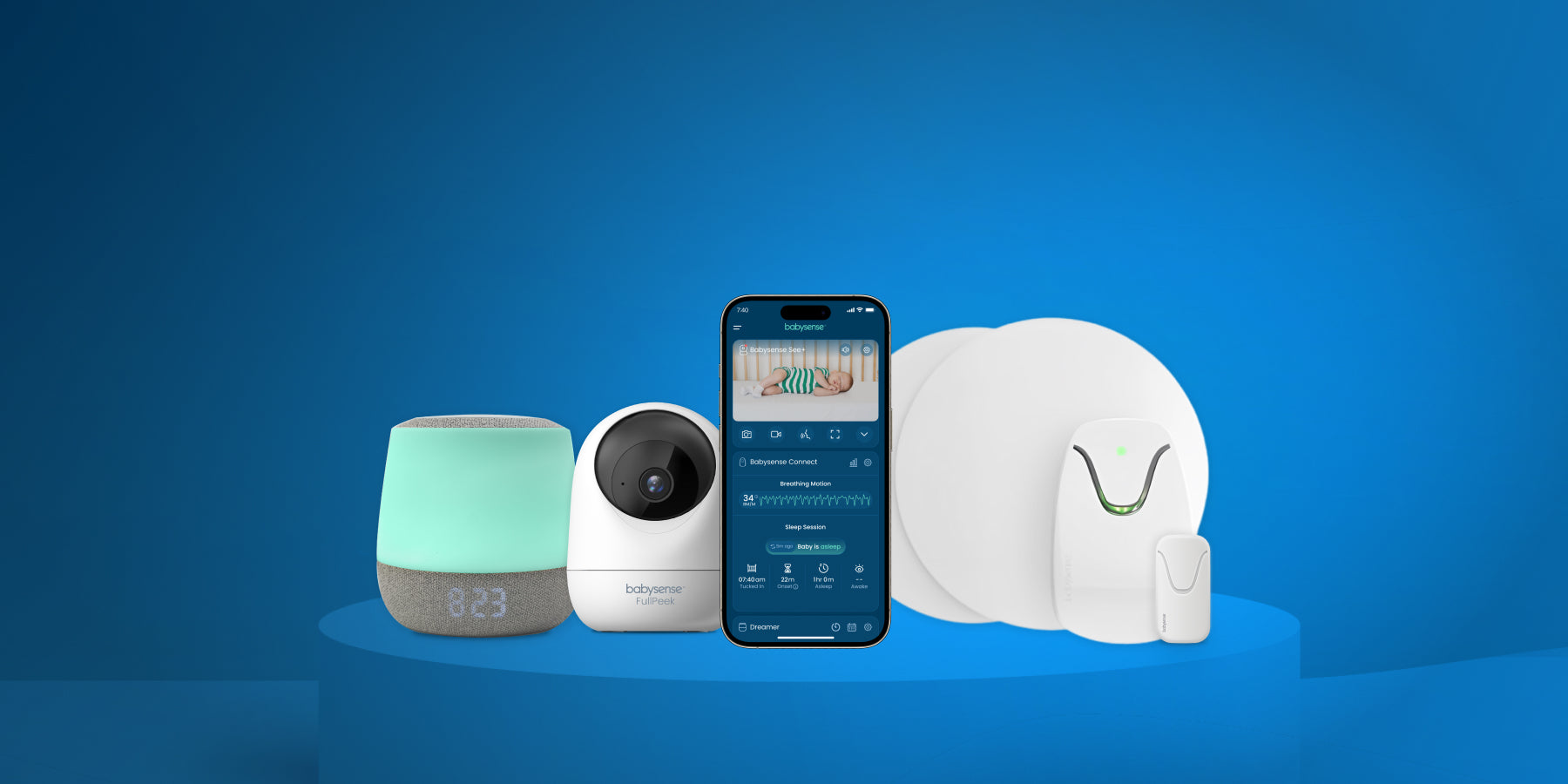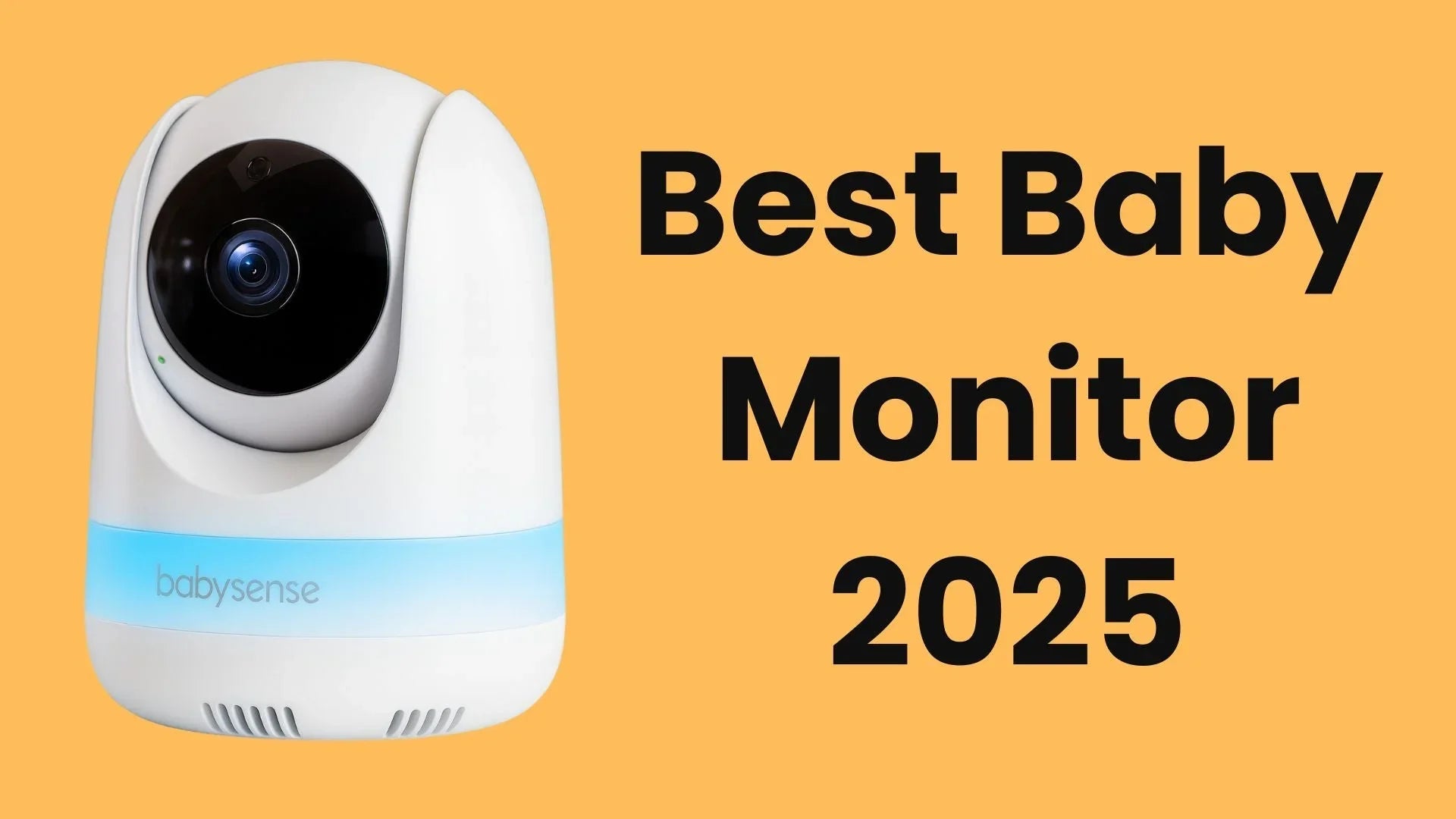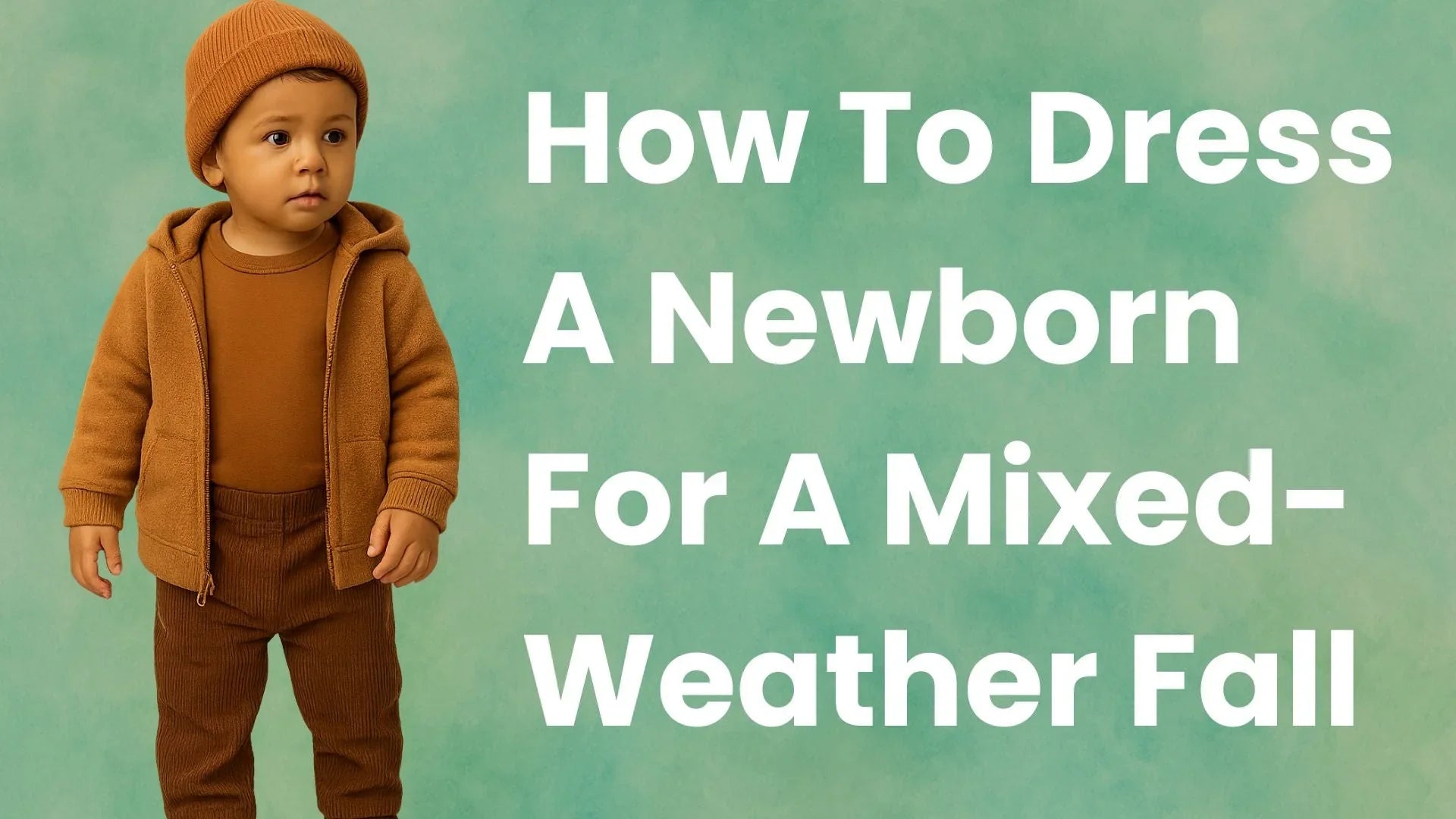Creating the perfect nursery environment is crucial for your baby's comfort, health, and sleep quality. Temperature and humidity control are two of the most important factors that directly impact your infant's wellbeing and development. Combined with reliable baby monitoring systems, proper environmental controls create the foundation for safe, peaceful sleep.
Why Nursery Temperature and Humidity Matter for Baby Safety
Babies are particularly sensitive to environmental changes because their thermo regulation systems are still developing. Unlike adults, infants cannot effectively regulate their body temperature, making them vulnerable to both overheating and getting too cold.
Proper temperature and humidity levels in the nursery help:
- Reduce the risk of Sudden Infant Death Syndrome (SIDS)
- Improve sleep quality and duration tracked by sleep monitoring systems
- Prevent respiratory issues and dry skin
- Support healthy development and breathing patterns
- Reduce fussiness and crying
Optimal Nursery Temperature Guidelines
Recommended Temperature Range
The ideal nursery temperature falls between 68°F to 70°F (20°C to 21°C). This range is recommended by pediatric sleep specialists and aligns with American Academy of Pediatrics guidelines for safe sleep environments.
Temperature Considerations by Season
Summer Months:
- Maintain 68-69°F to compensate for warmer ambient temperatures
- Use fans for air circulation (positioned away from baby)
- Consider lightweight sleep clothing
- Monitor with video baby monitors to check for overheating signs
Winter Months:
- Aim for 69-70°F as heating systems can create dry air
- Monitor for overheating if using space heaters
- Ensure adequate insulation to maintain consistent temperatures
- Use split-screen monitoring to watch multiple children during colder months
Signs Your Baby May Be Too Hot or Cold
Modern baby monitors with cameras allow parents to visually assess their baby's comfort level throughout the night. Look for these signs:
Too Hot:
- Sweating or damp hair
- Flushed cheeks
- Rapid breathing (easily monitored with breathing motion detection)
- Restlessness
- Hot chest or back of neck
Too Cold:
- Cool chest or back of neck
- Bluish tinge to lips or extremities
- Excessive crying
- Lethargy
- Cold hands and feet
Optimal Nursery Humidity Levels
Recommended Humidity Range
The ideal humidity level for a nursery is 30% to 50%. This range helps maintain respiratory health while preventing the growth of harmful bacteria and mold that could affect your baby's breathing patterns.
Why Proper Humidity Matters for Baby Health
Benefits of Optimal Humidity:
- Prevents dry, irritated skin and eczema flare-ups
- Reduces respiratory congestion that could trigger movement monitor alerts
- Minimizes static electricity
- Prevents furniture and wooden toys from cracking
- Inhibits dust mite proliferation
Problems with Incorrect Humidity:
- Too Low (Under 30%): Dry skin, nosebleeds, increased susceptibility to infections
- Too High (Over 50%): Mold growth, dust mites, uncomfortable stuffiness that disrupts sleep
Essential Monitoring Equipment for Temperature and Humidity Control
Advanced Baby Monitoring Solutions
Smart Video Baby Monitors: Modern video baby monitors often include environmental monitoring features alongside visual surveillance. The Babysense MaxView series provides crystal-clear HD monitoring while allowing parents to observe environmental comfort indicators.
Integrated Monitoring Systems: Comprehensive solutions like the Babysense Smart Nursery combine video monitoring, breathing motion detection, and environmental controls in one app-controlled system.
Temperature Monitoring Tools
Digital Room Thermometers:
- Provide accurate, real-time readings
- Look for models with wireless connectivity for remote monitoring
- Consider units with high/low alerts that complement your baby monitor system
Hospital-Grade Monitoring: Professional monitoring systems like those used in breathing motion detection often include temperature alerts as part of comprehensive safety monitoring.
Humidity Control Equipment
Humidifiers:
- Essential in dry climates or during winter months
- Choose cool-mist over warm-mist for safety
- Look for models with automatic shut-off features
- Regular cleaning prevents bacterial growth that could affect respiratory health
Dehumidifiers:
- Necessary in humid climates or poorly ventilated spaces
- Help prevent mold and mildew growth
- Choose appropriately sized units for your nursery square footage
Seasonal Adjustments and Smart Monitoring
Summer Temperature Management
During hot weather, maintaining cool nursery temperatures requires strategic planning combined with reliable monitoring:
- Use energy-efficient air conditioning set to 68-70°F
- Install blackout curtains to block heat-generating sunlight
- Position cribs away from windows and heat sources
- Monitor comfort levels with non-WiFi baby monitors for secure, hack-proof surveillance
Winter Humidity Control
Cold weather and heating systems often create dry indoor air that can affect breathing comfort:
- Run humidifiers to maintain 30-50% humidity
- Monitor breathing patterns with contact-free movement monitors
- Consider whole-house humidification systems
- Use smart nursery systems that integrate environmental and safety monitoring
Safe Sleep Environment Guidelines
Clothing and Bedding for Optimal Temperature Control
Appropriate Sleep Clothing:
- Use lightweight, breathable fabrics like cotton
- Follow the "one additional layer" rule compared to adult comfort
- Consider sleep sacks instead of loose blankets
- Monitor comfort levels with HD video monitors that provide clear nighttime visibility
Bedding Safety:
- Keep cribs free of loose blankets, pillows, and bumpers
- Use fitted sheets appropriate for crib mattress size
- Choose breathable mattress materials compatible with under-mattress movement sensors
Room Setup for Optimal Air Flow and Monitoring
- Position cribs away from heating/cooling vents
- Ensure adequate space around the crib for air circulation and camera placement
- Keep nursery doors slightly open for air movement
- Install multi-camera monitoring systems for comprehensive room coverage
Health Implications and Monitoring Solutions
Overheating Risks and Detection
Overheating is a significant risk factor for SIDS. Research indicates that babies who sleep in environments that are too warm face increased health risks. Modern breathing motion monitors can detect changes in breathing patterns that may indicate temperature-related distress.
Signs of dangerous overheating include:
- Core body temperature above normal range
- Excessive sweating (visible through HD night vision cameras)
- Dehydration symptoms
- Irregular breathing patterns detected by movement sensors
Cold Exposure Concerns
While less common than overheating, exposure to cold temperatures can also pose risks:
- Increased caloric needs for temperature regulation
- Potential respiratory stress monitored by real-time breathing detection
- Disrupted sleep patterns tracked through sleep analytics
- Increased crying and fussiness
Technology Solutions for Modern Parents
Smart Home Integration with Baby Monitoring
Modern smart home systems work seamlessly with advanced baby monitoring solutions:
- Programmable thermostats with scheduling capabilities
- App-controlled monitoring systems for remote temperature and safety alerts
- Integration with WiFi baby monitors and environmental sensors
- Automated alerts for temperature, humidity, or breathing irregularities
Professional-Grade Monitoring Applications
- Hospital-trusted movement monitors that track micro-movements
- Secure, hack-proof systems for reliable monitoring
- Historical data tracking for pattern identification through sleep analytics apps
- Multi-room monitoring with split-screen capabilities
Advanced Environmental Monitoring Features
Integrated Safety Systems
Modern baby monitoring has evolved beyond simple temperature checking. All-in-one systems now combine:
- Environmental monitoring (temperature, humidity, air quality)
- Contact-free breathing detection
- HD video surveillance with night vision capabilities
- Sound and light management for optimal sleep environments
Breathing Pattern Analysis in Different Environments
Temperature and humidity directly affect breathing comfort. Movement monitoring technology can detect subtle changes in breathing patterns that may indicate environmental discomfort:
- Slower breathing in overly warm conditions
- Irregular patterns in dry air environments
- Restless movement indicating temperature discomfort
- Real-time alerts for any concerning changes
Troubleshooting Environmental Issues
Inconsistent Temperatures
Causes and Solutions:
- Poor insulation: Add weather stripping or insulation
- Drafty windows: Install storm windows or heavy curtains
- HVAC issues: Schedule professional heating system maintenance
- Monitor effectiveness with long-range baby monitors (up to 1000ft range)
Humidity Problems and Breathing Monitoring
Too Dry:
- Add multiple humidifiers if necessary
- Monitor breathing comfort with non-contact movement sensors
- Consider houseplants that naturally increase humidity
- Use two-way audio features to soothe if baby becomes fussy from dry air
Too Humid:
- Improve ventilation with fans or vents
- Use dehumidifiers appropriately sized for the space
- Monitor for any breathing changes with real-time detection systems
- Check for water leaks or moisture sources
Creating the Ultimate Safe Sleep Environment
Multi-Layered Safety Approach
The most effective nursery setup combines environmental controls with comprehensive monitoring:
- Environmental Control: Maintain 68-70°F temperature and 30-50% humidity
- Visual Monitoring: Use HD video baby monitors for constant visual supervision
- Breathing Safety: Implement under-mattress movement detection for breathing monitoring
- Smart Integration: Utilize app-controlled systems for comprehensive oversight
Hospital-Trusted Safety Standards
Professional-grade monitoring equipment, like the Babysense movement monitors used in hospitals, provides medical-device-level accuracy for home use. These systems are particularly important when environmental factors might affect breathing comfort.
Energy Efficiency and Cost Considerations
Cost-Effective Climate Control
Maintaining optimal nursery conditions doesn't have to be expensive:
- Use programmable thermostats to reduce energy waste
- Invest in long-battery-life monitors (up to 20 hours) to reduce energy consumption
- Choose Energy Star certified appliances
- Utilize eco-mode monitoring features to extend battery life
Long-term Investment Benefits
- Quality climate control equipment pays for itself through energy savings
- Reliable monitoring systems reduce anxiety and healthcare costs
- Better environmental control means improved sleep for the whole family
- Modular monitoring systems grow with your family's needs
Red Flags: When Environmental Monitoring Becomes Critical
Immediate Medical Attention Required
Contact your pediatrician immediately if you notice:
- Persistent overheating despite proper room temperature
- Signs of dehydration or heat exhaustion
- Respiratory distress or difficulty breathing (especially important to monitor with breathing detection systems)
- Unusual lethargy or unresponsiveness
- Skin rashes or irritation that worsen with environmental changes
When to Upgrade Your Monitoring System
Consider enhanced monitoring if you experience:
- Frequent concerns about baby's breathing during temperature changes
- Need for multi-room environmental monitoring
- Desire for professional-grade safety alerts
- Integration of environmental controls with comprehensive baby monitoring
Expert-Recommended Monitoring Setup
Step-by-Step Implementation
- Assess Current Conditions: Use accurate thermometers and hygrometers alongside video monitoring
- Install Safety Systems: Set up breathing motion detection as a foundational safety layer
- Optimize Visual Monitoring: Position HD cameras for clear temperature assessment capabilities
- Integrate Smart Controls: Use app-based systems to manage both environmental and safety monitoring
- Test and Calibrate: Ensure all systems work together seamlessly
Professional Recommendations from Pediatric Sleep Specialists
Pediatric sleep consultants and child development specialists emphasize these key points for environmental control:
- Consistency is more important than perfection
- Continuous monitoring provides better insights than periodic checking
- Individual babies may have slightly different preferences
- Hospital-grade monitoring standards provide the highest level of safety assurance
Creating Your Complete Nursery Safety Plan
Comprehensive Environmental and Safety Monitoring
The most effective approach combines environmental control with multi-layered safety monitoring:
Foundation Layer: Environmental Control
- Maintain optimal temperature (68-70°F) and humidity (30-50%)
- Use quality heating, cooling, and air circulation systems
- Monitor conditions with digital sensors
Safety Layer: Breathing and Movement Monitoring
- Install under-mattress movement sensors for contact-free monitoring
- Use hospital-trusted technology for medical-grade accuracy
- Set up instant alerts for any breathing irregularities
Visual Layer: HD Video Surveillance
- Deploy split-screen monitors for comprehensive room coverage
- Utilize night vision capabilities for 24/7 monitoring
- Enable two-way audio for immediate response
Integration Layer: Smart Control Systems
- Implement all-in-one monitoring solutions for unified control
- Use app-based management for remote monitoring and alerts
- Access detailed sleep analytics for pattern optimization
Maintenance and Monitoring Schedule
Daily:
- Check temperature and humidity readings via monitoring apps
- Review overnight alerts from breathing detection systems
- Observe baby for comfort signs through video monitors
Weekly:
- Clean humidifier/dehumidifier filters
- Check battery levels on monitoring devices
- Review sleep pattern analytics
Monthly:
- Deep clean humidity control devices
- Test all safety alert systems
- Assess seasonal adjustment needs
Advanced Features for Modern Nursery Management
Next-Generation Monitoring Capabilities
Today's most advanced nursery setups incorporate:
- 3MP Super HD cameras for crystal-clear environmental assessment
- Dual-sensor movement detection for maximum accuracy
- RGB nightlight integration that doesn't interfere with sleep
- White noise and sound management for optimal sleep environments
Privacy and Security in Environmental Monitoring
With increasing connectivity, security becomes paramount:
- Choose hack-proof, non-WiFi systems for maximum privacy
- Ensure encrypted data transmission for WiFi-enabled devices
- Use secure, dedicated parent units rather than smartphone-only solutions
Common Mistakes to Avoid
Environmental Control Errors
- Over-relying on baby's hands and feet temperature (these are naturally cooler)
- Making frequent dramatic temperature adjustments without monitoring breathing responses
- Ignoring humidity in favor of temperature-only focus
- Placing monitoring equipment too close to heating/cooling sources
- Not utilizing comprehensive monitoring systems that track both environmental and physiological factors
Monitoring System Mistakes
- Relying solely on visual checks instead of continuous movement monitoring
- Choosing monitors without medical certification
- Not testing alert systems regularly
- Forgetting to account for false alarm prevention features
Conclusion: Building the Perfect Nursery Environment
Maintaining optimal temperature and humidity in your baby's nursery is a fundamental aspect of creating a safe, comfortable sleep environment. By following the recommended ranges of 68-70°F and 30-50% humidity, combined with professional-grade monitoring systems, you can provide your baby with the ideal conditions for healthy growth and development.
The integration of environmental controls with advanced baby monitoring technology represents the gold standard in modern nursery safety. Systems like the Babysense monitoring solutions, trusted in hospitals worldwide, provide parents with unprecedented peace of mind through medical-grade safety monitoring.
Remember that every baby is unique, and slight variations in preferences are normal. The key is consistency, careful observation through reliable monitoring systems, and gradual adjustments based on your baby's cues and comfort signs. When in doubt, consult with your pediatrician or a certified sleep consultant who can provide personalized guidance for your specific situation.
Creating the perfect nursery environment is an investment in your baby's health, development, and your family's overall wellbeing. With proper environmental controls, comprehensive monitoring technology, and attention to detail, you can maintain optimal conditions that support peaceful sleep and healthy growth throughout your baby's early years.





